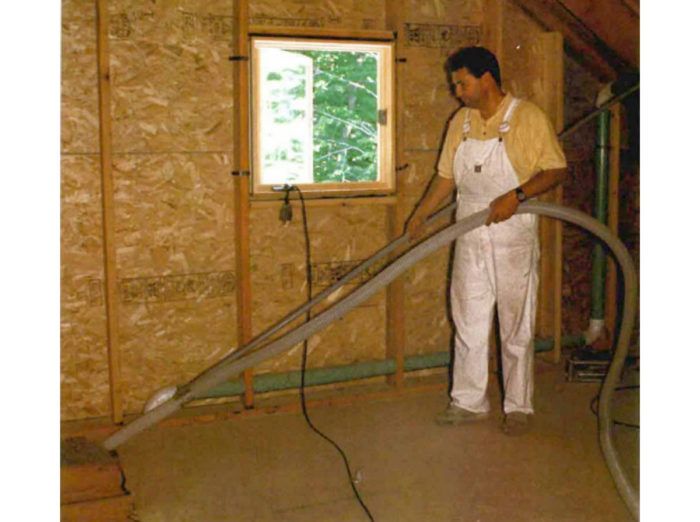Insulating With Cellulose
Blown in behind the drywall, high-density cellulose air-seals as it insulates.

Synopsis: Blown-in cellulose has become a widely used form of residential insulation, and the equipment used to install it can be rented by builders or homeowners who don’t want to hire an insulation contractor. This article describes how cellulose should be installed in walls and ceilings.
Technicians determine insulation R-values in a lab, at 75°F in a horizontal chamber. Insulation is fully fluffed and precisely fitted to all sides of this compartment. There are no gaps or air currents. Under these conditions, for example, 6-in. thick fiberglass batts achieve R-19.
However, compress this R-19 insulation into a 5-in. wall where it is exposed to sub-zero air leaking past gaps in the sheathing; where wires, pipes and ducts push aside the insulation to create uninsulated gaps; and where air circulates within the cavity. The actual whole-wall R-value may then fall somewhere in the range of R-6 to R-10.
Install these R-19 batts in an open attic, and outdoor air circulates through uncovered insulation, heating or cooling the ceiling. Insulation that doesn’t firmly contact the ceiling, or fit snugly to the joists, or whose ends are wind-washed with air from soffit vents, can functionally disintegrate to R-4.
For batt insulation to be fully effective, its framing cavity must be sealed against air infiltration. That means caulking the sheathing and drywall to the plates, sealing all the holes where wires, pipes and ducts penetrate the plates, and sealing the electrical boxes to the drywall. On real construction sites, this type of preparation is rare.
Cellulose fills the gaps
Dissatisfied with insulation performance, I sought better methods. This search led me to blown cellulose. Although cellulose also requires good installation to insulate to its full potential, I found that near-perfect installation is much easier to achieve with blown cellulose than with fiberglass.
Cellulose is composed mostly of recycled newsprint, which originates, of course, from wood pulp. Aluminum and borate salts added to cellulose make it fire- and pest-resistant. Because it retains wood’s cellular structure, cellulose is naturally nonconductive. It isn’t wholly dependent on trapped air, as is fiberglass, for its insulative value. Therefore, cellulose holds its R-value at high densities, which allows a particularly effective insulation method called dense-packing.
Dense-packing requires a blowing machine and hoses to transport the material to the house and into walls and ceilings. I insert the hose into the entire lengths of enclosed framing cavities such as joist and stud bays and turn on the blower. When the pack becomes dense enough to stall the machine, I yank the tube out about 1 ft. This step restarts the flow and places the hose tip in loose cellulose to begin packing again. You can expect insulation packed into walls and ceilings this way to offer a reliable R-3.5 per in. of thickness.
Dense-packed cellulose works well for two chief reasons. First, it flows around obstacles to insulate cavities fully, even those chockfull of wires and pipes. Second, it seals air leaks as it’s installed. By physically blocking cold infiltration and the escape of heated indoor air, we always get substantially more comfort and energy conservation than the insulation could produce from simply resisting conduction.
With dense-packed cellulose, I don’t install vapor diffusion barriers (typically plastic sheets behind drywall). Almost all moisture entering framing cavities is blown in on air currents; no air leaks mean little chance of moisture trouble.
For more photos and details, click the View PDF button below:
Fine Homebuilding Recommended Products
Fine Homebuilding receives a commission for items purchased through links on this site, including Amazon Associates and other affiliate advertising programs.

Smart String Line

Disposable Suit

Utility Knife


























